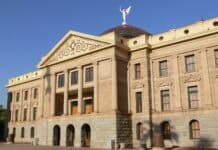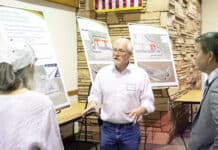Wastewater and sewers aren’t the most appetizing of topics, but they’re the most expensive items on Sedona’s financial menu.
By Susan Johnson
Larson Newspapers
Wastewater and sewers aren’t the most appetizing of topics, but they’re the most expensive items on Sedona’s financial menu.
In response to a request from the Sedona Red Rock News, candidates for mayor offered their thoughts on the subject as follows:
What are the environmental and financial risks in the city’s current drainage and sewer infrastructure?
* City Councilman Rob Adams: “Stormwater runoff from parking areas, streets and construction projects are running into washes and then into Oak Creek, containing contaminants such as herbicides, oil, vehicle fluids, construction spillages.
“Violations of the city’s stormwater prevention program occur all too frequently.”
“The city is at risk for fines or worse from ADEQ,” Adams said.
* Incumbent Mayor Pud Colquitt: “Worst-case [scenarios] of the environmental risks are failing septic systems leaching into the aquifer and also leading to non-compliance.
“In the event that drainage is also a problem along with failing systems, then the environmental risk is even higher,” she said.
“Financial risks include the impact on the capital fund and construction continuing to spiral upward, thus increasing the [financial] risks,” Colquitt said.
* Candidate Matthew Turner: “Environmental risks include failure of old sewer systems and piping leaking into the city environment, destruction of roads/sidewalks, personal property and homes.”
“Financial risks are that the city doesn’t have extra funds or ample sales tax revenues to cover problems and pay for improvements,” Turner said.
What is your estimate of future costs related to sewers and drains over the next five years?
* Adams: “I am going to have to refer you to [the city’s] Public Works [Department] for this answer. I assume they have provided the answer.”
* Colquitt: “Costs will be $7 million to $8 million in sewering the Chapel and $3 million to $4 million for drainage in the Chapel and Harmony areas and this doesn’t include costs relating to maintenance of existing system such as the upgrade of existing pumping stations.”
* Turner: “I estimate it will cost approximately $20 million to get all the developments on sewer, including the Chapel area, Broken Arrow, Saddle Rock, Cibola Hills, Uptown, Sky Mountain and Casa Manana.”
If elected, from what source will you allocate funds to pay for those future costs?
* Adams: “Sewer has its own fund. Fortunately, we have about $25 million in reserve for this fund.
“Stormwater management is paid for through the capital fund. We have around $100 million in capital projects that need to be addressed at some time in the future.”
“[Another] option would be a general obligation bond which is a form of property tax,” Adams said.
“This bond would go to the voters to authorize the city to initiate a property tax with a sunset clause for specific capital projects,” Adams said.
* Colquitt: “For the sewer, funding would come from wastewater user fees generated from the $32.54 monthly fee per equivalent residential unit, sales tax revenues which come from the 1.38 percent sales tax for wastewater debt, capacity fee revenues collected from the one-time $4,900 fee per equivalent residential unit required for residents and businesses to connect and from bond revenues.”
“For drainage, funding comes from development impact fees, funds received from Yavapai and Coconino counties, possible improvement districts, bond revenues, franchise fees paid by UniSource Energy Services, APS [Arizona Public Service], Sedona Cable, Arizona and Oak Creek water companies and the flexible capital improvement budget,” Colquitt said.
* Turner: “I would continue to use funds from sales tax revenues [and to increase those revenues] by promoting Sedona throughout European communities and on major travel networks in order to generate the money needed to complete the projects we want to do locally.”
How much of the city’s investment should focus on new infrastructure and how much on repair and maintenance of existing operations?
* Adams: “In the case of the sewer, a majority of the funds should go to repair and maintenance at this time.”
“Infrastructure should be installed when funding is available,” Adams said.
* Colquitt: “Considering that 73 percent of the city is already sewered, preventive maintenance is imperative.
“It is vital to keep the existing system in top condition, considering the costs of repairs and the fact that the life of most of the pumps are 15 years or less.”
“Much of the new sewering will be done by developers hooking up to the existing lines or, in some cases, laying new lines,” Colquitt said.
Turner: “Areas of the sewer that are the oldest and most in need of repair should be addressed first. Then, we should focus 80 percent on new sewer and 20 percent on older sewer lines that need repair.”
“However, I am concerned that we don’t have the funds necessary to make emergency repairs,” Turner said.
Susan Johnson can be reached at 282-7795, Ext. 129 or e-mail sjohnson@larsonnewspapers.com





















